Background
I like wildcats.
And being an avid predator/varmint hunter, I’ve gravitated toward ‘hotrod’ type cartridges…fast & flat is where it’s at!!! Maximum point blank range and terminal performance on critters are key elements for a ‘hotrod’ to improve upon, over factory available cartridges. Ideally, the performance gains should justify the extra time, effort & expense of wildcatting. At least that’s what I keep telling myself, LOL. We all want what we want, and all like what we like, but I can always take enjoyment to learn about what other wildcatters have done in the past, and hope to try in the future…
Several years back, I built a .22-243 Win. The 1:7.7 Krieger launched 75Amaxs in the 3500 fps range, and they sure can fly at that launch speed! While at a coyote contest in Nebraska, a friend had a (slow twist) .22-243AI for sale and lucky fella got a deal on a badazz coyote killer. After seeing that .22-243 Win & AI side by side, I just couldn’t stop wondering what that “Improved” case could do with a faster twist??? So, wound up going home & soon had built a .22-243AI on a 1:8 Brux. Since then, that rifle that has been my favorite coyote killer. When hunting ‘out west’, the wind bucking and flat shooting ability is something to behold! And needless to say, it kills coyotes just as handily back here at home in the Northeast. Even with fireforming loads, the .22-243AI is a “hell on wheels” woodchuck round! And with a sturdy Barnes TSX, it makes a heck of a deer killer…
Fireforming brass on summer ‘chucks & LR steel targets was good fun, and the AI’ed case allowed for mild velocity gain over my previous straight .22-243Win. A longer freebore spec, plus a full case of slow burn H1000 allows the .22-243AI to run ‘cooler’, mitigating throat erosion for this overbore cartridge. I have one coyote killin’ friend in particular who built one at the same time, and he’s already swapped a new barrel on his .22-243AI after 1500 rds of 80Amaxs. That and it still shoots under well 3/4 MOA as a fireforming barrel. Lots to like about the .22-243AI!
So, where’s this all going, you might ask? Well, the same ‘wildcat’ itch has begun to fester inside. I kept looking at my SAUM brass, and Redding 7SAUM dies…wondering “what if”…
What if I necked a SAUM case down to .224?
That question has been bouncin’ around in the brain bucket for a few years now. Well, a wild hair grew from my azz, and decided to spend some time on what this monster might behold???
Goals & Expectations
With a baseline of performance & happiness established with fast twist .22-243AI, and a hankering to neck down a SAUM, I began looking into other larger capacity .224 hotrods to see how high the sky was. Cartridges like the .220 Swift AI & .22-6mm (.224TTH) didn’t offer much of anything over a short action .22-243AI, but the .22-6mmAI, .22-06 & AI, .22-284 Win and others like the .224 Clark & .224 Vias did. As they say in racing, there’s no replacement for displacement!
After researching a bit on each, I realized that simply necking down a SAUM case would provide for all the case capacity of any of the above, and then some. Reading of velocity claims of those established wildcats just piqued my interest, further. Just didn’t see any reason why a SAUM based .224cal hotrod couldn’t, at the very least, match any of the aforementioned? And at best, flat out blow their doors off! But without getting too obscene, I settled on attaining an honest 3750fps from a 75-80gr bullet, and doing it from a hunting rifle. IE, no 30″ barrels, I’m talking a 26-27″ finished length barrel on a carry rifle. So, that’s where I’ve set the bar, and we’ll just hafta see if & how much a .224 cal. SAUM can clear it by…if at all? Regardless, it’ll be fun to try! So…here we go!!!
Barrel Twist Considerations
Based on sound advice and past experience, when considering an overbore wildcat, Priority #1 to consider is: bullet integrity. My .22-243AI runs a 75Amax @ near 3600fps from a 1:8 twist barrel, which generates in the neighborhood of ~324,000 RPM. Needless to say, that is ALOT of spin! Every bullet handles RPM differently, depending on its design & construction. Going over the edge on RPM may result in bad things happening. Everything from inconsistent penetration & “splashing” on animals, to outright “poofs” where the bullet never even makes it to the target. So, keeping a bullet intact & happy is of paramount importance! With the tangible increase in case capacity over most any a .224 caliber hotrod, a SAUM is very capable of pushing a 75-80 fast enough to make ’em quit…
That established, what’s easy answer to address excessive RPM? Easy answer: slow down the twist rate. For the sake of conversation, let’s assume 3750fps as an easily attainable MV for a 75gr bullet from this .224 caliber SAUM wildcat. From a 1:8 twist barrel, that 75gr bullet would be spinning over 337,000RPM!!! NOT GOOD…that number kinda scares me. I sure don’t wanna invest all this time, effort & expense to start blowing bullets up after only a few hundred rounds down the pipe. And I sure don’t want the bullets that can handle that stress to be “splashing” on a coyote. The whole idea is to kill a coyote with extreme prejudice & authority…where they stand! And seeing how a .224 centerfire is legal for big game in my home state, I will look forward to using this wildcat as a deer rifle. With the appropriate bullet, of course…
However…if ya drop down to a 1:9 twist, at the same 3750fps launch speed, that 337,000 RPM magically drops to 300,000. Still ALOT of RPM, but that decrease should be infinitely more ‘bullet friendly’ to the various 75-80 grain bullets I’m hoping to test. Keep those bullet jackets intact, and put those coyotes in the dirt! That’s the idea, anyway…
Before calling the 1:9 twist good all around, bullet stability must also be addressed. Needing some indication that a given bullet will fully stabilize from less twist, I referenced:
Berger’s wonderful Stability Calculator!
http://www.bergerbullets.com/twist-rate-calculator/
Given a MV of 3750 fps, a 75gr VLD is “marginally stable” from a 1:9 twist barrel, with a factor of 1.2. That is @ sea level & 30°F, atmospherics toward the lower end of intended use. Given that conservative MV estimate for this project, I’m OK with a stability factor of 1.2. so that finalizes the twist rate for this .224 SAUM @ 1:9. A quick call to Ken @ Brux Barrels in Wisconsin got a 1:9 twist blank in #4 contour on the way…
Brass and Dies
Now then, what brass should I use? As stated earlier, having a collection of various SAUM brass and a set of Redding Type S dies on hand was a factor in deciding to build this .224 caliber wildcat. Necking down from .300SAUM is not my idea of practical, especially given that there is 7SAUM and 6.5(SAUM) 4s brass on the market. Having some brandy new Norma 7SAUM brass on hand made using it a safe bet. I do have Hornady “6.5GAP 4s” headstamped brass, but chose to keep that for my other rifles. Plus, its always easier to run one particular headstamp in one particular rifle, to avoid confusion…
Beyond having brass & dies to use already in hand, I employed a few Redding bushings I already had as well. Granted, this may not be the ‘ideal’ way to neck down brass, but I made it work with little/no fuss. Virgin 7SAUM brass necked down in three steps. Before doing so, I did remove the stem from my Redding Type S FL 7SAUM die, so it would not interfere with the decreased neck ID. A bit of Imperial Sizing Wax, and here we go!
1st bushing: .291
2nd bushing: .270
final bushing: .258″
That was easy!!!
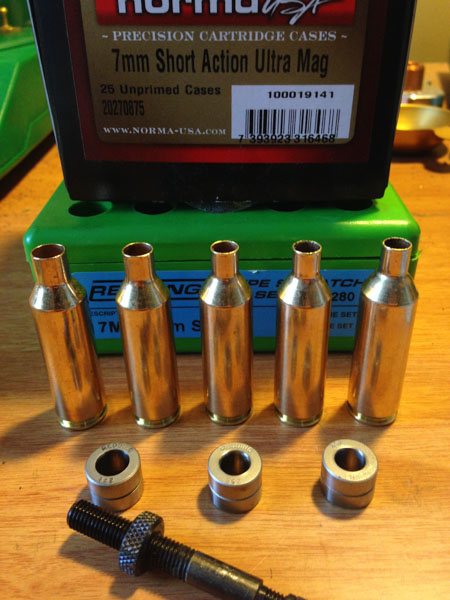
Turning And Trimming The .220 Redline
Now…on to addressing the next potential hurdle: neck thickness & concentricity. As you’ll soon note, I decided on that last .258″ bushing for a reason. Using that diameter as the last step in necking down the 7SAUM brass allows for a very close fit on to a .224″ mandrel. As is turned out, running those necks thru a .224 caliber K&M ExpandIron only opened the necks about .001″. Just enough to get those necks to slide onto the K&M turner mandrel without unduly working the brass…
After truing ID on the .224″ ExpandIron, I measured neck thickness & concentricity on a Redding Case Neck Concentricity Gauge. Given all that squeezin’ down, concentricity was actually not terrible. But the necks did vary from .018-.019″ in diameter, which is a bit thicker than I’d care to run. So…time to bust out the K&M neck turner! But first, have to address case length, as all that necked down brass has to go somewhere. Case length increased over .010″ from virgin 7SAUM (~2.023—>~2.034″) So, a quick trim got them all uniform @ 2.025″, and now the shoulder will index true on the neck turner…
Set the K&M up and got to shavin’!
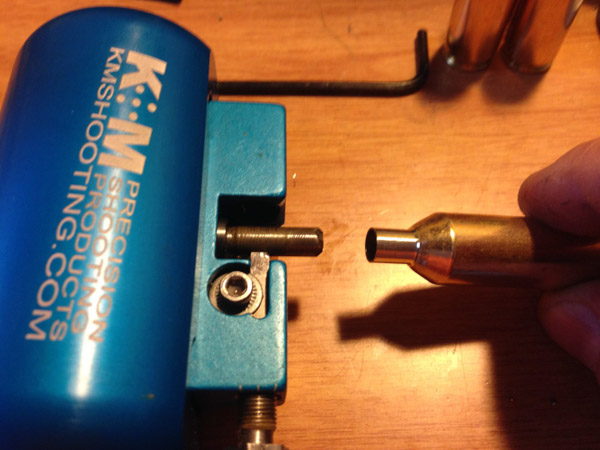
I did feel the cutting mandral take a bit of material from inside the neck, and I turned juuuust slightly into the shoulder to keep any potential issue of ‘donuts’ at bay. Viola, a nice, true .015″ neck thickness..
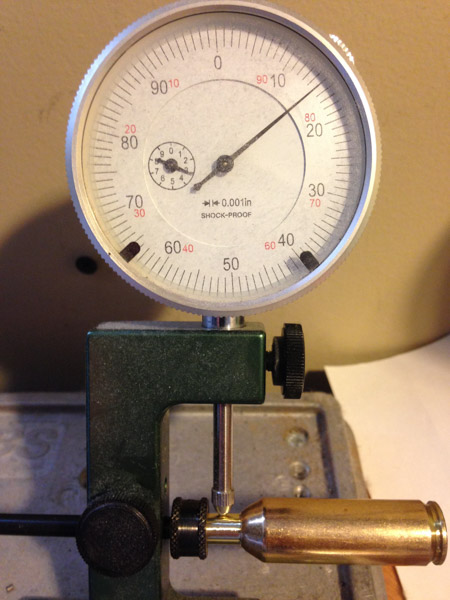
With a loaded round measurement of .254, (.224″ + .015 + .015), the .252 bushing in the pic above will allow .002 tension upon re-sizing. Should work OK for the time being, but may require some ‘tweaking’ when load testing commences. If this monster shoots & yields the performance I’m hoping to achieve, I can see a set of custom dies in the future. But for now, having a loaded round in hand is something we can work with toward designing a reamer print…
Bullets
Final thing, pick a bullet & find a seating depth! I touched upon earlier about bullet weights. Ideally, I’d like to run 75-80gr bullets from this wildcat. Seeing as how those finished cases ended up with nice, I didn’t want to start too long on OAL. Especially for a fire-breathin’ dragon like this! Basically, I eyeballed an 80Amax up & went from there. ‘SWAG’ science, if you will! Here’s an 80Amax @ 2.770″, base of bullet is just above the shoulder, and there’s plenty of bearing surface left to chase lands:

This length isn’t set in stone, I just wanted to get a baseline ‘dummy’ round sent out to JGS to get an idea on freebore length. Grant @ JGS Precision Tool in Oregon was a pleasure to deal with. He got a reamer print back to me for confirmation very quickly. The freebore settled upon was exactly what I’d calculated on my own & should allow a variety of 75-80gr bullets to work…
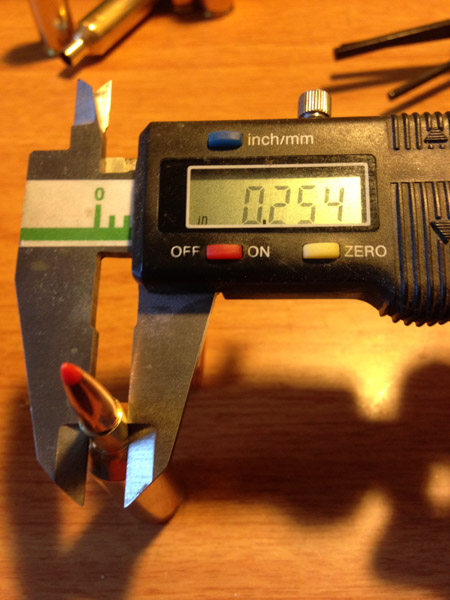
What To Name It?
Since this monster wildcat is gonna run right at/beyond the limit of any .224 caliber I’m aware of, the name just sorta came to me: REDLINE. And .220 just rolls better in front, so that settles it! A semi-tight necked .22-7SAUM… now to be known as my .220 REDLINE.
For reference, here’s a finished .220REDLINE dummy round with an 80Amax @ 2.770″. Shown next to a 6.5SAUM4s & 140JLK @2.930″:
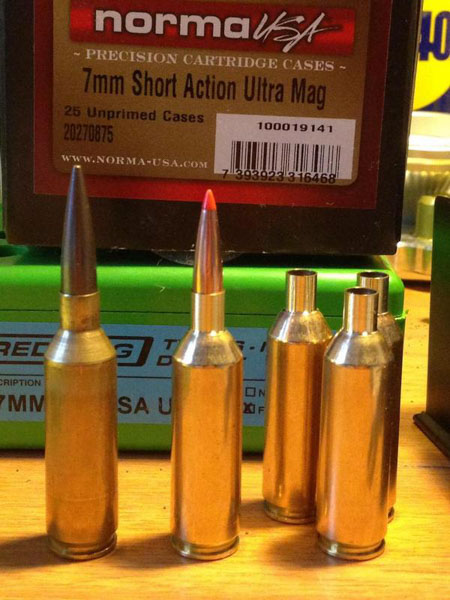
That about does it, for now!
As of the time of this writing, action, barrel, reamer & dummy rounds are at the gunsmith. Will be following up with Part 2 when barreled action is back in hand. Stay tuned for Part II, where I’ll get into the rifle components, and beginning of load testing…
– Fred R
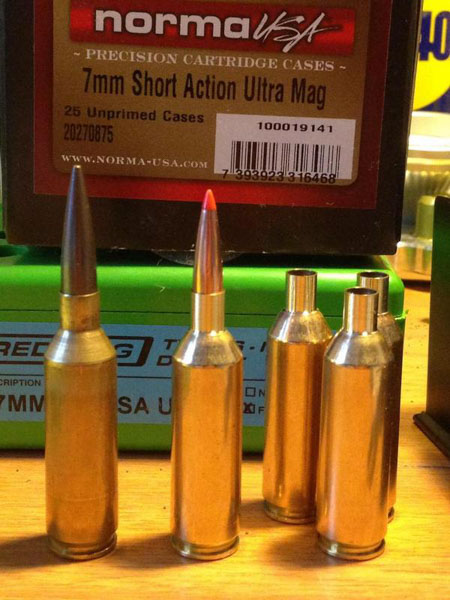


Great write up Fred! Can’t wait for the shooting to start in part 2!
Damn sweet Fred! Great work.
Very intriguing, can’t wait to hear testing/performance results.
Me too!
This is a really cool concept! looking forward to seeing how this turns out. With a 80gr ELD-m going 3700 this will have 4.1 Mils (13.9MOA) of drop at 1k. Pretty wild!
Very interesting project, Fred.
As with most of this stuff, I wonder if 300,000RPM will be optimum, terminally, and with accuracy ?
Dave, I had no idea you had this blog?
El Bee
Well now you do Leonard! Thanks for dropping in and commenting – appreciate it!
I am a huge Swift fan, and 17 Rem fan, and anything that shoots flat and whacks coyotes fan. Luckily I stumbled on to your page while searching for info on the 17 Predator and the 30 gr. Gold bullet. I have a 17 rem., a pair of Swifts and a 300 SAUM in a stainless Model 7 which I was contemplating rebarreling in the predator. I live by the rule of a fast high BC varmint bullet out of an easy to carry rifle so your Predator has struck my interest to say the least, however now that I found your other article on the 220 redline I am torn. Keep the info coming, I am enjoying all of it and can’t wait to see the end result on the redline. Meanwhile, maybe I will just go ahead and build a Predator while I’m waiting. Keep doing what you do, I’m enjoying the helpful info.
Thanks for the kind words Davy, always happy to hear that. And yeah, build one while deciding is always a good idea, lol!
Once you are a Wildcatter you can’t help yourself. I started reading your article and before I got to the end I wanted to go out and research some wildcat and build a rifle.
It’s a sickness with no cure – thankfully.
Ain’t that the truth!
Interesting build. Have the heavy bullets been tested before at these higher vel? (75-90 gr.) Been doing a little work with the New 224 Valkyrie and 90 gr. Sierra Matchkings on a AR platform.
I’m not sure if they have or not. This is the first I’ve seen of pushing 75’s and 80’s this fast. Fred has been doing some shooting with it lately, starting load work. He is getting some unreal performance. I’m anxious for his update!
Damn Fred I’m proud of you and impressed with this round so far looking forward to your results Rick